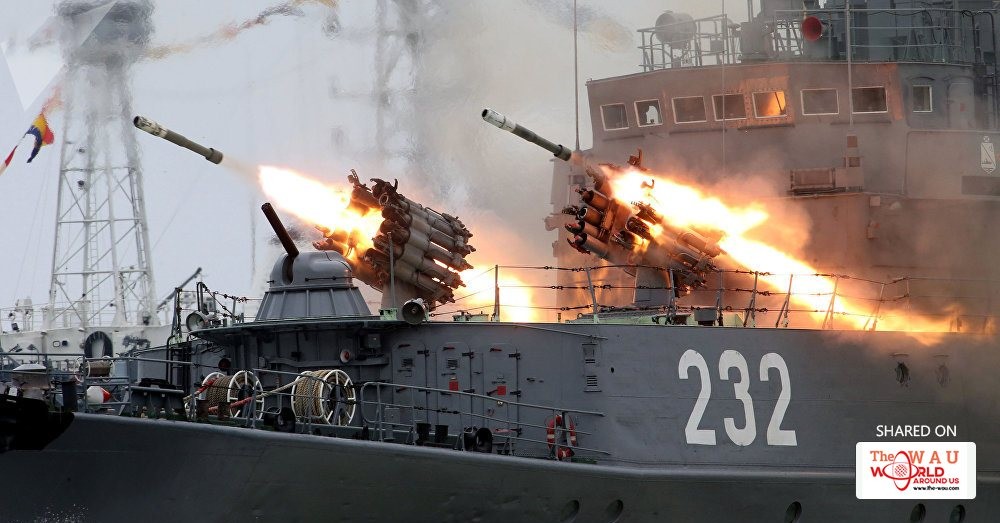Splav, a Tula, Russia-based company specializing in multiple rocket launcher systems for land and naval applications, has unveiled a new guided projectile for the RPK-8 Zapad ('West') anti-submarine rocket launcher system. Independent Russian military analyst Vladimir Tuchkov explains the ins and outs of the upgraded rocket.
The new rocket, designated the 90R1, is being featured at the St. Petersburg International Maritime Defense Show, which wraps up Sunday. Earlier this week, Splav's press office confirmed that the projectile had already been put into production, and is starting to enter service aboard Russian Navy ships.
Splav also showed off another system, the Magnesit-MN, at the defense show. That rocket, also fired by the RPK-8, features hydro-acoustic elements providing surface ships with protection against homing torpedoes.

Commenting on the capabilities the new rockets will provide the Russian Navy, independent military analyst and Svobodnaya Pressa contributor Vladimir Tuchkov wrote that it's important to note, first of all, that they are wedded the RPK-8, an anti-submarine warfare system with a long and proud history.
"The RPK-8 is a relatively new antisubmarine weapons system, adopted in 1991," the expert recalled. "The system was a deep modernization of Smerch-2, developed three decades earlier. The effectiveness of Smerch-2 as a means of anti-submarine warfare…was not high. It was used mainly to repel enemy torpedo attacks, since it was equipped not with self-guided torpedoes, but depth charge bombs. Smerch-2 was created by the well-known Moscow Institute of Heat Engineering, which would subsequently go on to develop the Topol mobile land-based ICBM carrier."

The Splav Scientific Production Concern adopted from Smerch-2 its twelve 212mm launch barrels to create the RBU-6000 anti-submarine rocket launcher. That system featured a new, remotely directed fire control system, and more importantly, rocket projectiles instead of depth charge bombs. The upgrade did not lead to a loss of functionality, however, and both the RBU-6000 and its RPK-8 upgrade are capable of launching Smerch-2's RGB-60 depth charge bomb rounds.
The RPK-8's 90R and its 90R1 upgrade's rockets consist of two parts: the rocket itself, plus a separating gravitational diving projectile.
Tuchkov explains: "The rocket is aimed at its target (vessel or torpedo) using information about its location received from the ship's sonar station. After splashdown, the gravitational projectile separates and, with the aid of an acoustic homing head, finds its target and directs itself toward it. The 90R has a contact fuse." The 90R1, meanwhile, features an inductive noncontact fuse what goes off when the projectile reaches a certain predetermined distance from its target, thus further improving its efficiency.

According to the expert, the 90R and 90R1 guided rounds increase the ASW system's effectiveness 8-10 times compared to its Smerch-2 predecessor, "whose bombs were launched, figuratively speaking, by blind luck."
The 90R has a range between 600 m and 4.3 km, and a depth of up to one km. The range of its acoustic homing head is 130 m. The 90R1 is believed to feature improved range, although these have yet to be revealed in open sources. In any case, Tuchkov noted that "it can be assumed that designers did not increase its depth characteristics, since 1,000 m is beyond the limits of any NATO submarine or torpedo."
The analyst writes: "The 90R has advantages over traditional torpedoes in use against submarines. Because its gravitational projectiles lack an engine, they can move without being tracked by enemy sonar. They can be detected with the help of active sonar, but this mode of operation by an enemy vessel gives away its location even further. Moreover, it doesn't make much sense anyway: As a rule, major underwater targets are targeted by volleys of twelve rounds at once, and due to the reflection of the sonar waves from all twelve projectiles, a complex interference pattern is obtained, making it impossible to accurately determine the position of attacking warheads."
...[ Continue to next page ]
Share This Post















